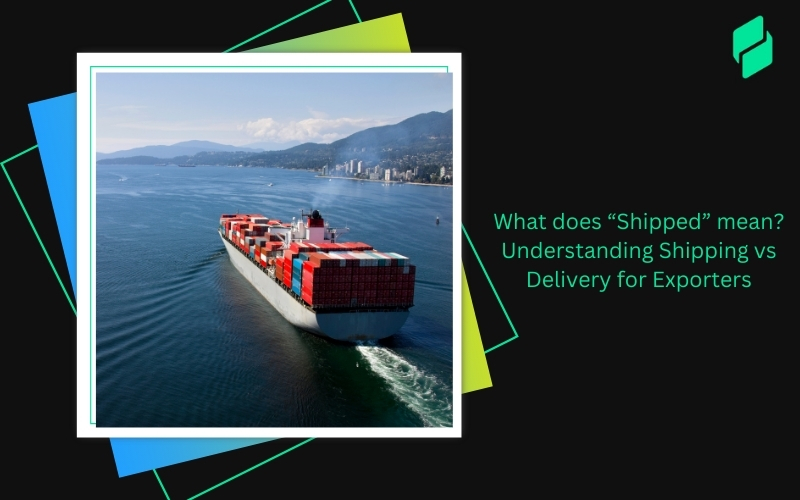Optimize your business: use unlimited savings with Pazago fulfilled now!
Get Started ->Did you know that India ranks as the 6th largest producer of chemicals globally? With the chemical sector contributing about 7% to India's GDP, it's clear that this industry plays a major role in the nation's economic growth. But despite its impressive standing, many businesses still don't fully tap into the potential of exporting chemicals.
If you're a small and medium-sized enterprise (SME) looking to expand globally, this could be the perfect time to enter the chemical export market. Why? Because India's chemical products are in high demand across the globe, from the United States to Southeast Asia.
This blog will explain the necessary steps and strategies to help you successfully start chemical export from India, whether you're already in the business or just getting started.
Overview of Chemical Exports from India

India's chemical export industry is growing. Between April and September 2024, exports of organic and inorganic chemicals reached an impressive $14.09 billion, signalling strong global demand for Indian chemicals. This growth is set to continue as markets worldwide increasingly turn to India for high-quality, cost-effective chemical products. Some of the top chemical exported from India(organic and inorganic) include:
Top Markets for Chemical Export From India
India's chemicals find demand in several global markets, including:
- United States
- Brazil
- China
- United Arab Emirates
- Saudi Arabia
With the basics in place, let's move on to the step-by-step process of exporting chemicals from India.
Also Read: Import and Export Trade: Understanding Its Impact and Strategies In India
Step-by-Step Guide to Exporting Chemicals

If you're an SME looking to enter the chemical export business, the process may seem complex, but with the right guidance, you can make it straightforward. Here's a simple, step-by-step guide to help you through the journey of exporting chemicals from India.
- Registration and Licensing
Before you can start exporting, there are some official steps you need to complete:
- Obtain an Importer Exporter Code (IEC): This code is essential for all export transactions. To obtain it, you must apply online at the Directorate General of Foreign Trade (DGFT) website.
- Ensure GST Compliance: If your turnover exceeds the prescribed limit, you'll need to register for Goods and Services Tax (GST).
- Understanding Regulations and Certifications
The chemical export industry is regulated both in India and internationally. Here are the key regulatory aspects to be aware of:
- Domestic Safety Standards: In India, you must ensure your chemicals meet safety standards set by the Bureau of Indian Standards (BIS). These standards cover aspects like packaging, labeling, and safety measures.
- International Compliance: You may need additional certifications depending on the country you're exporting to. For instance:
- REACH Compliance (for EU markets): Ensures your chemicals meet EU health, safety, and environmental standards.
- ISO Certifications: While not mandatory, certifications like ISO 9001 (Quality Management) and ISO 14001 (Environmental Management) can help improve your credibility in international markets.
- GHS Compliance: The Globally Harmonized System (GHS) of Classification and Labelling of Chemicals may be required, particularly for markets like the US.
- Market Research and Identifying Opportunities
Before you start exporting, understanding your target market is key. Here's how to go about it:
- Analyze Demand: Research the specific chemical exports from India that are in high demand in various countries. For example, organic chemicals like benzene are highly sought after in the United States, while caustic soda and soda ash have strong demand in Brazil and Southeast Asia.
- Utilize Trade Agreements: India has Free Trade Agreements (FTAs) with several countries and regions, which can help lower tariffs and make your exports more competitive. Keep an eye on the trade policies of countries you want to export to.
- Explore New Markets: Don't limit yourself to just the traditional markets. Emerging regions like Africa, the Middle East, and Southeast Asia are seeing substantial demand for chemicals, offering fresh opportunities for export growth.
- Documentation and Logistics
Proper documentation and logistics management are crucial to ensuring your exports reach international buyers on time and in good condition. Here's a breakdown of the key documents and steps involved:
- Key Export Documents:
- Shipping Bill: This document is filed with Indian Customs for the export of goods.
- Commercial Invoice: Lists the transaction details, including the price, quantity, and description of the chemicals.
- Packing List: Provides details on how your chemicals are packed, including the number of cartons, weight, and volume.
- Bill of Lading/Airway Bill: This is the proof of shipment issued by the shipping or airline company.
- Logistics Management: Efficient logistics are vital to ensuring your chemicals arrive safely and on time. Partner with trusted freight forwarders and customs brokers who understand the regulations of your destination country.
Once you've established your business, it's time to access resources that can give you a competitive edge.
Also Read: Guide to Export Documentation Procedure
Role of CHEMEXCIL and Export Promotion Councils

Exporting chemicals can be complex, especially for SMEs just starting out. This is where organizations like CHEMEXCIL (Basic Chemicals, Cosmetics & Dyes Export Promotion Council) can play a key role in simplifying the process and providing valuable support.
CHEMEXCIL is a government-backed council designed to help Indian chemical exporters navigate the global market. As a member, you'll gain access to a range of services and benefits that simplify the export process and support your business growth.
Services and Benefits Provided by CHEMEXCIL:
- Market Research and Trade Information: Provides you with up-to-date information on global market trends, helping you identify demand for your chemical products in different regions.
- Buyer-Seller Meets: These events are great chances to meet potential buyers and expand your network.
- Promotional Activities: Supports SMEs by providing marketing assistance helping you promote your products in international markets through digital and physical channels.
- Access to Funding and Subsidies: Guide you on export-related financial support and schemes available to SMEs. This includes help with availing subsidies and export credits to reduce financial barriers.
While these councils offer invaluable support, it's important to understand the challenges you might face in the export process.
Also Read: Demystifying RCMC: Understanding Its Significance in Export Business
Challenges in Chemical Export

Exporting chemicals from India comes with its challenges. Here's a quick overview of the key hurdles you might face:
- Compliance with International Regulations: Different countries have strict safety and environmental standards. Regulations like REACH in the EU require thorough documentation, and non-compliance can lead to shipment delays or rejections.
- Fierce Competition: India faces stiff competition from global chemical exporters, especially from countries like China and the US. To stand out, focus on quality, pricing, and customer service.
- Logistical Hurdles and Cost Fluctuations: Rising fuel costs, customs delays, and special handling requirements make managing safe and cost-efficient transport for chemicals challenging.
- Currency Fluctuations: Exchange rate fluctuations can affect pricing and profit margins. Consider favorable payment terms to hedge against these risks.
- Risk of Non-Payment: Dealing with new markets can involve the risk of non-payment. To secure your transactions, use payment terms like letters of credit or advance payment.
Despite the hurdles, the future of chemical exports looks brighter than ever—here's why.
Also Read: Understanding the Meaning and Impact of Logistical Issues
Opportunities and Future Trends

The global demand for chemicals is only expected to grow, presenting numerous opportunities for Indian exporters. As the world shifts toward new technologies and sustainable practices, the chemical export industry is also evolving. Here are some trends and opportunities to look out for:
- Growing Demand for Sustainable and Green Chemicals
Sustainability is becoming a priority for industries worldwide. Many countries are focusing on eco-friendly products, so there is an increasing demand for green chemicals. These include biodegradable products, non-toxic alternatives, and renewable chemical resources. Indian exporters can capitalize on this trend by innovating and adapting to the growing preference for sustainable chemicals.
- Expansion of Specialty Chemical Markets
The demand for specialty chemicals is on the rise, driven by sectors such as automotive, electronics, and pharmaceuticals. These highly specialized chemicals often have a smaller, niche market but offer higher profit margins. India's chemical industry, with its diverse product offerings, is well-positioned to meet this demand.
- Emerging Markets
While traditional markets like the US, Europe, and China remain important, emerging markets in Africa, Southeast Asia, and the Middle East present new growth opportunities. These regions are industrializing quickly and require various chemicals for their growing manufacturing and construction sectors.
- Technological Advancements
Advances in chemical processing technologies, such as automation and AI, are helping companies improve efficiency and reduce production costs. Indian exporters who adopt these technologies can increase their competitiveness in the global market.
Turning the challenges into actionable opportunities requires expertise, and Pazago provides comprehensive tools to simplify chemical exports.
Also Read: Top 10 Trends in Digital Supply Chain Management
How Pazago Simplifies Chemical Exports

Pazago is designed to simplify the entire chemical export process, making it easier for businesses to manage logistics, compliance, and communication. Here's how it works:
- Centralized Order Management: Pazago consolidates all purchase orders and simplifies workflows, reducing paperwork and making the process more efficient.
- Live Shipment Tracking: Track your shipments in real-time across 180+ carriers and 110+ countries.
- Quality Control Reports: Review inspection reports to make sure that your products meet the necessary quality standards and specifications.
- Insurance Management: Manage all aspects of shipment insurance directly through the platform, saving you time and ensuring your products are covered during transit.
- Financial Tools for Cost Control: Pazago provides tools to manage foreign exchange risks, payments, and financing, allowing you to control your costs and avoid unexpected expenses.
Pazago equips you with everything you need to excel, making your export journey smoother than ever.
Conclusion
Chemical export from India offers immense potential, with increasing global demand and emerging market opportunities. However, the complexities of compliance, logistics, and competition can pose challenges for SMEs. By simplifying your processes with platforms like Pazago, you can tackle these challenges and set your business up for success.
Pazago's comprehensive tools simplify every aspect of the export journey, from managing orders and tracking shipments to ensuring compliance and handling financials. Thus, you can focus on growing your business while minimizing risks and maximizing efficiency.
Explore Pazago today to take your chemical export business to the next level!


.png)








